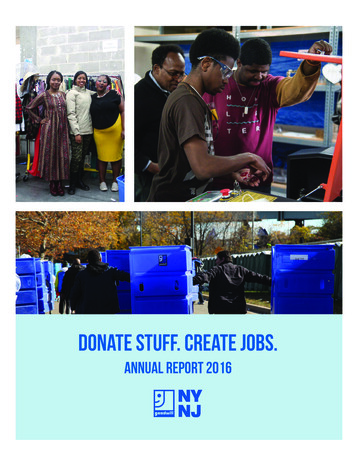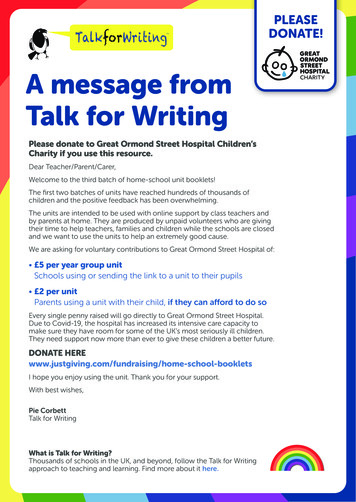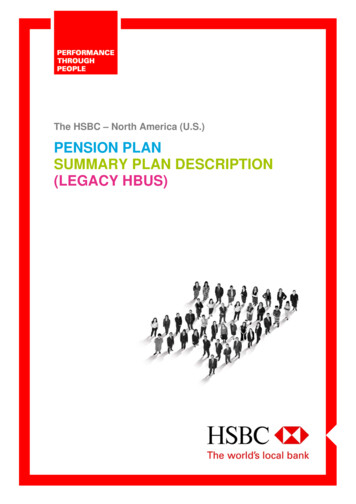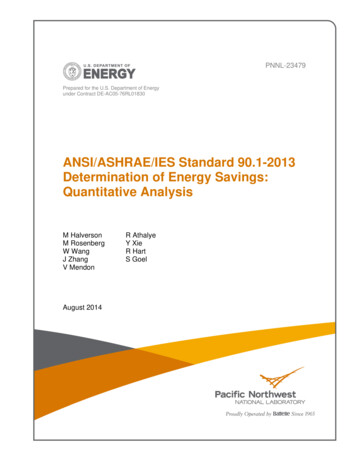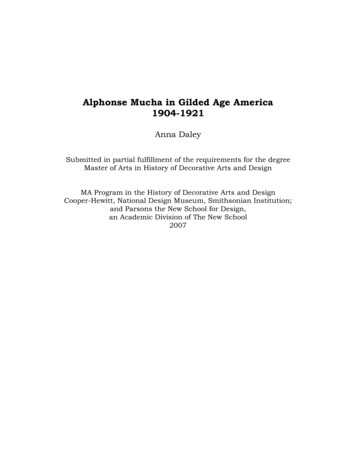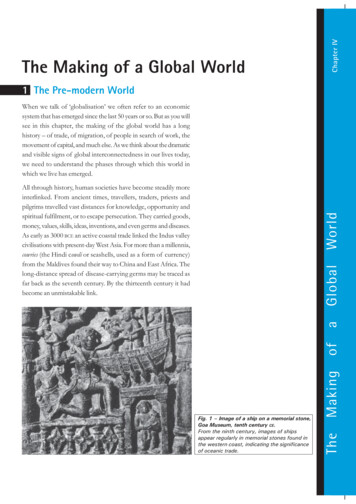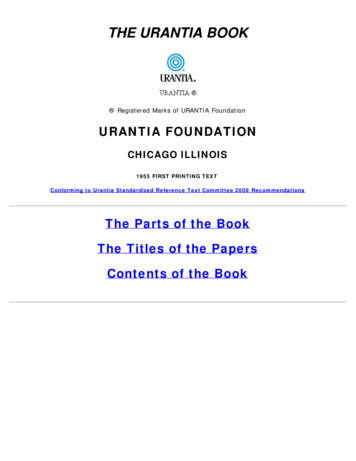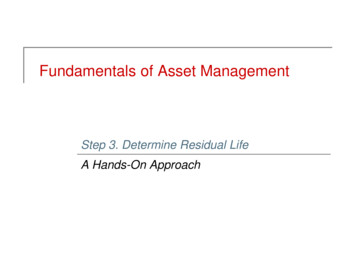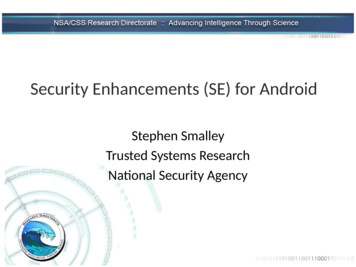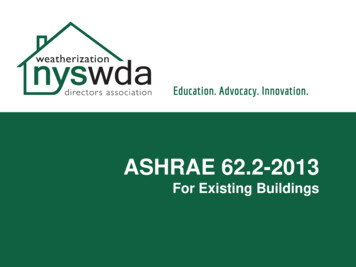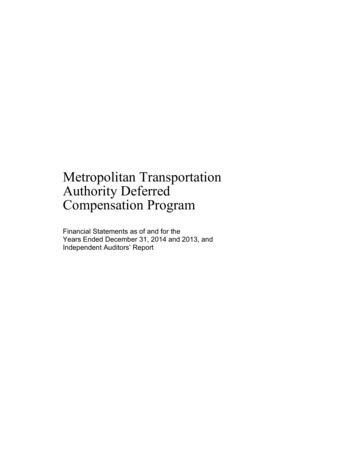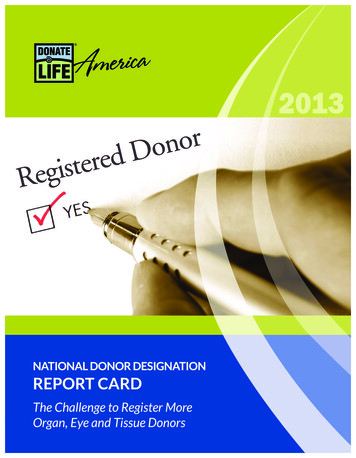
Transcription
2013national Donor Designationreport CarDThe Challenge to Register MoreOrgan, Eye and Tissue Donors
Our Mission for LifeTo drive individuals, organizations andcommunities to increase the number ofdesignated organ, eye and tissue donorswho save and heal lives.
Introduction1BackgroundDonate Life America (DLA) is invested in initiatives to increase donor designation nationwide. The DonorDesignation Collaborative, launched in 2006, has evolved into our standard of practice for advancingdonation, thus helping to save the lives of the tens of thousands of men, women and children awaitingorgan transplants and heal the hundreds of thousands more in need of corneal and tissue transplants.At the core of the collaborative effort are the gathering, evaluation and comparison of state registrydata. This analysis allows us to enhance the quality of systems that enable recovery agencies to followa donor’s decision to make an anatomical gift.Annually, data from the donor registries of all 50 states, the District of Columbia and Puerto Rico isreported through this National Donor Designation Report Card.Progress to dateIn 2012, as part of an effort to drastically increase the number of registered donors, DLA launched the “20Million in 2012” campaign. The aggressive goal of adding 20 million people to the 100 million alreadyregistered served as a bold statement about both the dire need for more donors and our commitment tosaving and healing lives. The campaign created excitement and successfully engaged more people to registerand to participate in countless activities to promote organ, eye and tissue donation across the United States.As a result of the building momentum and the focus on donor designation by the donation and transplantcommunity nationwide, 109 million individuals have registered as donors, 7.5 million of those registeredin 2012. Also in 2012, 40 percent of recovered organ donors, 45 percent of recovered tissue donors and 48percent of recovered eye donors were authorized through state donor registries. These growing percentageshelp facilitate the process of recovery agencies following a donor’s decision to make an anatomical gift.national Impact on donation, 2007-2012Designated Donors Among Recovered %42% 42%33%27% 820092010201120120%20072008200920102011201210%2007 eye data not available
2“Measuring our progress and growth over time as well as measuringthe success of individual states and individual campaigns to identifybest practices is key to our long-term success in achieving DLA’smission. This 2013 data report is the latest, best data data wecan use to look backward and to celebrate progress, and data wecan use to look forward as we strive for broad implementation ofbest practices and higher levels of success.”— Jeff OrlowskiBone graft restoresactive LifestyleDiagnosed with Ewing’sSarcoma at age 12, KristenMain was devastated to learnthat to stop the cancer fromspreading, her arm wouldneed to be either amputatedor debilitated by radiation.Fortunately, a bone transplantprovided another option.Thanks to the gift of a tissuedonor, the bone graft surgerywas a success and Kristenreturned to playing softballand water polo. Kristen wasoverjoyed to be back to heractive lifestyle. Eventually, shewent on to college at GrandValley State University, whereshe majored in criminal justice.After graduating in 2009, sheattended the police academy inGrand Rapids, MI, and is nowa police sergeant.Kristen, bone graft recipient, standing by herpatrol car with her niece and nephews“Donation is a gift that keeps on giving,”says Kristen. “I know this sounds cliché,but it truly changes someone’s life.”
National Status32012 Year-end dataEvery year, Donate Life America tracks progress to determine the increase in donor designation state bystate. Data is compiled and analyzed to establish four important measures: Total Donor Designation,Donor Designation Share, Donor Designation Rate, and Effective Registry Design. This information iscritical to identifying statesthat excel at donor designationso that successful programs candonor designation in the united statesbe replicated by other states.108,963,015 as of 12/31/12120,000,000donor desIgnatIonA Donor Designation is adocumented, legally authorizedcommitment by an individualto make an anatomical gift thatcannot be revoked by anyoneother than the registered 000,0000donor desIgnatIon shareThe Donor Designation Share is thetotal number of designated donors,as a percentage of all state residentsage 18 and older. The goal is for everystate to reach a minimum 50 percentDonor Designation Share.Some donor registries allow minorsto enroll, so these states will reflecthigher percentages. The date ofregistry inception may also affectthe number of people accountedfor in each registry and couldcause some states to have a smallernumber of registered donors thanexpected. Registries that haveexisted for many years have hada longer period of time to enlistdonors compared to more recentlylaunched registries.Q4 Q1 Q2 Q3 Q4 Q1 Q2 Q3 Q4 Q1 Q2 Q3 Q4 Q1 Q2 Q3 Q4 Q1 Q2 Q3 Q4‘07 ‘08 ‘08 ‘08 ‘08 ‘09 ‘09 ‘09 ‘09 ‘10 ‘10 ‘10 ‘10 ‘11 ‘11 ‘11 ‘11 ‘12 ‘12 ‘12 ‘12donor designation share in the united states50 states and DC as of 12/31/12108,963,015Designated Donors45%US Population Age 18 : 240,378,322
44 4D rThee DoDonornoDesignationr DeTheRateistherateat which individuals join the state donor registry as a percentageDesigsignatnatioionn RaRatete isis therattheratee atat whwhichich indindividuals joinividualsstajoiofofn theofalltheallorr goaldriverdristateregverlicenseste donof all driver’sandcardsissuedwithin a specificperiodtime.Anotherstate’s’s licedonoythatlicenasnsepersess andregistrcenistisryanIDtagged IDeIDcaras aaeachcardsissupercedsedd mrioe.achievAnachdievesofothestimergoaaa mine.minimachievesa 1,000peopleapplyfortheirlAnisimuumthaothm 50tereac50 pergohstaalpercecenntteist DothatDonoreach statenor DeDesigionn Rate. ForsignatnatioexamppleFordonorsle,ifif 1,0driverexamdriver’s’s least 500 registerRaaste.newor, choseto peoremaindonorsduringnse1,000seappor00ly forstastatepeoptetheIDletodaptodayplyandayforanatd attheirat lea500irleastst 500 regr oss DesignationRate.ainchthathaisosedontt isis aa 50toorsremdur50 peringainpercecenntt DodonoDonorrs duringnor DeDesigionn Somenecessary to calculate Donor Designation Rate. Fortunately, ortthethethedatadata necdataesssarnecesaryy toto calatee DocalculculatyeaDonoryeaatiornor DesinrsinceDesignce2006,sig2006200year sinceable to ,additionaltionn Ra, stateshavteshaveebeentelly,havebeey, even echsysntsansystemofgintem. SomthegireleSomee stamentsstatestes stilof theirstilll strugglstruge to meet theglecenntt minwemustpenationalmustcontinueimuumrcem andconticonwebest practices so that50thepercanbed achieved.migoaltinnuuntueesharingnimil thesharinginformationyy doaninformatiountilthenandationanddo so,and besso,bestt practices so that thecticesionnaall goathe natnatiolcanbegoal can be achachievieved.ed.%50%50nationalrate 2008-2012national donordonor designationdesignation rate te for donationaaYoung advoca te for ddonaonattioio n201220122012a child, Alfonso Garcia wanted to follow in his brother’s footsteps as anAsAsAschild,aa child, AlfAlfononso GaGarciasowantentedd torcia wato folfolllowow inamateurboxerandmilitaryman.in hishis brobrothether’sr’s foofootsttsteps asamateas anateuramanur boboxer anandepsxermillitaitard miyman.ry man.in January 2010, Alfonso quickly fell into a spiral of decliningBuBut,Buin Jant,t, inJanuauar201ryy 20Alffonons100,, Alo ququiickckllyythatsofelll inthealthand becameveryill.“IlearnedI hadrevealsintspiralfelral ofofdisease,”decoo aaWilson’sspiheaheandaltlthh and bedebeccliliniamee verninngvergin thecamyill.“I leaylearnerneill.dwhich“Ithatt pperhaddWithalson’s dishad Wilson’sdiseasease,”e,” revAlfrevealonsealssAlo, “afon“anso,inherieritn inhedexcessdisordordcopperteder indisin whwhdamagesich theertherebody’s tissue.Theliverandnervoussystem.retheis �s tissueue. Thpper in theThee exexcesscopcesperdamcopper das thethetold agegesliveandnervouliverr ansysAlfonso’sDoDoctorstem.ctorsDors tolnectotoldrvome thauss systhadmettemIhadjustItdayhaduntils toto livjust retraonsure wafutnspo’swass unlant.” Alfonso’uncertaincer, ununttaisn,regististetililothers.redaa regdonlifeandthelivesoftwoorerenamddoGeorgnor nameedorgee savsavedlife aned hisd Gehisandlifethe livd theliveof twtwoess ofotherso others.Alfonso’snewliverhasgiven him renewed focus on what’s important in life.AlfononsAlfo’snewlivso’s newlivehasgivenerrhaenhimhimrens felife.s isparentsjoined tDonorDonateLifeAmbassadorsto helpspreadparsooanentd hisjoinedthetherenCalifotssjoiTranspliforniaa o, ,liveliverrliverspreadwordrecieadtherecrs ioincludeonsn.hasfonappsoohaearedurging .s glifothernimtoa ocationtionneduionininthethehighigh“Ischool“I �I was on ant recipients, such as Alfonso Garcia, show gghsplanrecipih aamipiet recntsmisuchhaasthroughairamiracle,I amracenisn’tclele,ts, ,sucas, IIamAlfamonsoGaGarciAlorgan s oGarcia’sstoryremindsof ctteofDotor ofDonal, rrannornia.a.anddand“Alfohilfonsohisrnis ��sorgandonationgifdonorhisI emindindss orsislaofthetorabshumof eyes.”the humaanabouelemettGoumenteoorgGentininorgbrings tears to theirrgeeevn ”day.”bringandngsbritearsrstonaatios teationnantothetheirireyedeyes.”s.”
Effective Registry CriteriaThe Donor Designation Collaborative determined that the design of a registry plays a key role in its effectiveness.Over the years, several factors have been identified as critical, and each year more state registries have beenable to make changes to meet these criteria. They include:1. No follow-up step required for Department of Motor Vehicles or online enrollment,allowing a registration to take effect without unnecessary delay.2. Active legislation that authorizes recovery agencies to honor a donor’s decision to makean anatomical gift with no further requirement for family authorization for organ, eyeand tissue donation. Legislation makes a donor’s decision the priority and preventsdelays due to confusion or indecision that could result in the organs and tissue no longerbeing viable or preventing the donation from taking place.3. 24/7 access to the system by organ, eye and tissue recovery agencies to search donordesignations. A system that limits the times a registry can be searched also limits thenumber of donors. Making a registry searchable 24/7 ensures that designated donorsare identified immediately and allows donation professionals to follow the donor’sdocumented decision.4. Department of Motor Vehicles enrolls donors via driver’s license and ID card applicationsand renewals by all available channels, including field office, online and mail, maximizingopportunities to designate a donation decision.5. Individuals can enroll online through a dedicated website, providing potential donors theability to register their decision at any time. Whether it is time to renew their license ornot, a person can register their decision through this dedicated website.6. Individuals can enroll by completing a paper form or registry brochure form. Multipleregistration channels allow those without a license or ID card or access to the Internet toregister. It also allows people to designate a donation decision at health fairs, conferencesand community events.7. Department of Motor Vehicles donor records are searchable within one week of enrollment.It is essential that registrations can be acted upon whenever a person becomes a candidatefor donation.Note: The names of licensing offices vary by state, i.e. Department of Public Safety in Texas,Bureau of Motor Vehicles in Indiana and Department of Motor Vehicles in Virginia.5
2012 State Comparisons6If the 50 percent minimum Donor Designation Share or Donor Designation Rate has been met or exceeded or effective registentire state row is highlighted. Note again that some states are unable to report Donor Designation Rate. These states will haStateDonorDesignationsStatePopulation18 t.of onorDesignationsat DMVDLs & IDsIssued byState 9107,76080.3%20041996199220072008
7registry design criteria has been met, these numbers are highlighted in green. When minimum criteria in all areas are met, thewill have some blank cells.DonorDesignationsStatePopulation18 vada834,802357,793864,07741.4%2001New 5,88555.5%1980’sNew 0North 7,46446%4,468,4709,787,64645.7%1994StateNew JerseyNew MexicoNorth DakotaDonorDesignationsat DMVDLs & IDsIssued byState 920031,794,0303,123,67157.4%2004Puerto RicoRhode 8,32245%26,162,76662,688,68542.0%South CarolinaSouth DakotaWest 7551,686,58759.6%20041991
Crucial Next Steps8As more state registries reach “maturity” (definedas an effective registry that has gone through acomplete driver’s license and ID card renewalcycle), it is necessary for the donation communityto focus particular efforts on those segments ofthe population that have proven most difficultto register.18 percent stated that they “do not have the time todo it” or “haven’t gotten around to it;” and 13percent were confused as to how they should register.According to research by DLA and others, barriersthat prevent U.S. adults from deciding to becomeregistered donors include: 25 percent said they had not registeredas donors because they “had not heardabout it.” 30 percent said they “have not gottenaround to it.” A majority of respondents also intendedto register “soon” or “one day.” lack of urgency lack of understanding or knowledge ofthe registration process fear that in an emergency doctors willnot try as hard to save the lives ofregistered donors.With this in mind, while continuing to reach outto everyone, DLA is also placing special emphasison multicultural communities with long-heldmisconceptions; those over 50, who may erroneouslythink they are too old to be donors; and the youngadult demographic, 18-24 year olds, who registerat a less than average rate. For this year’s ReportCard, we focus our examples on 18-24 year olds.Quantitative research conducted by Donate LifeAmerica in 2010 revealed that 76 percent of alladults 18 years and older who wish to donate atleast some of their organs and tissue believe theyare registered to be organ or tissue donors. Thatnumber drops to 66 percent among the 18 to 24demographic. Of those 18-24 year olds not registered,14 percent said they had “just not considered it” andOther research of this age group, conducted by theBritish Columbia Institute of Technology for theCollegiate American Marketing Association revealed:At DLA’s annual meeting in 2011, marketingexpert Rebecca Ryan of Next GenerationConsulting described how young adults areaching to be a part of something larger thanthemselves. Whether due to a personal senseof responsibility or a desire to become morewell-rounded citizens, young adults want tobe taken seriously as future funders, volunteersand leaders for the issues they care about.Donate Life America and its constituency arecommitted to reaching out to this group with acompelling message of hope and urgency and toprovide clear instructions on the registration process.We must not only instill a sense of immediacy ofthe need for more registered donors, but also tapinto their drive and passion and engage them asadvocates who will influence their peers to make thedecision to register as organ, eye and tissue donors.
personally touched by donation and transplantationSuccessful ProgramsReaching 18-24 Year Oldsregistered donors before and after “Your decision to donate” videoCalifornia Transplant Donor Networkages 13-24Raw #% ChangeGift of Life Michiganunder age 20Raw #% ChangeYear beenprior toMany initiatives havedeveloped to reachout to those not-yet registered donorsof this generation.213,12344,972The following areimplementationtwo successful outreach programs.Year afterimplementation302,52842%2 years afterimplementation387,50628%113,23452%new guinness World3 years after23%recordimplementationset for Most 476,361organ donorPlease note that other changes in public education and outreach may also be a factor in donor registration increases.registrations in a dayGift of Hope Organ & TissueDonor Network, in partnershipwith the University of IllinoisUrbana-Champaign, set a newGuinness World Record forregistering the most people asorgan donors in a single, 8-hourday. Gift of Hope nearly tripledthe previous record by registering2,262 organ donors on August26 at the University’s 2012 QuadDay event.Students who registered as part of Quad Day“Through the collective action and selfless decisionsof more than 2,000 people, we have shown theworld that the University of Illinois is committed totransforming lives, not only inside the classroom,but outside the classroom, as well.”“We are very proud of setting thisnew Guinness World Record, butwe are even more proud of the factthat, by setting this record, we willultimately make more lifesavingorgans and healing tissue availableto those in need,” said Kevin Cmunt, President/CEO of Gift of Hope. “We are extremely gratefulto the University of Illinois community for its generous support of our lifesaving mission.”University of Illinois Vice President and Chancellor Phyllis M. Wise applauded the Universitycommunity for its strong support. “We challenged students, faculty and alumni to help break theGuinness World Record and save lives by registering as organ donors during Quad Day, and theysuccessfully met that challenge,” she said.Donor challenge events can be done through registered student organizations or during WelcomeWeek fairs where students learn more about campus and community resources. Events like theseprovide the perfect opportunity to engage with students and discuss organ, eye and tissue donation.9
10California High SchoolProgram SpreadsOne approach used to reach young adults hasbeen to educate teenagers before it is time forthem to apply for their first learners driving permit,where they will have the opportunity to designatethemselves as organ, eye and tissue donors. Note:This serves as an indication of intent until theregistrant’s eighteenth birthday at which point itbecomes a legal authorization. Various educationalprograms are in place across the United Statesthat include special curriculums, videos andliterature to be used by teachers in either science,health or driver’s education programs. If studentsdo not make a decision when they are 15-16 andare first exposed to the opportunity to registerthrough the DMV, it becomes more difficult toreach them between then and the next time theyare renewing their license in four to twelve years,depending on the state.In 2010, Donate Life California worked withGOAL Productions to create a new video aimedat educating and inspiring teens to join the state’sdonor registry. Titled “Your Decision to Donate,”the video includes interviews with three teenagerspersonally touched by donation and transplantation– a liver transplant recipient, a kidney transplantrecipient and a donor sister. Complementing thesepowerful stories is an interview with a transplantsurgeon and information about joining the donorregistry when applying for a driver’s license.The video was created so that it could be easilymodified for other states, enabling eleven additionalstates thus far to use it. Details on donor registrychanges in the target age groups is not consistentlyavailable from all states, but here is a sampling ofchanges seen in two Donation Service Areas thatused the video between 2010 and 2012.registered donors before and after “Your decision to donate” videoCalifornia Transplant Donor Networkages 13-24Gift of Life Michiganunder age 20Raw #% ChangeRaw #% ChangeYear prior toimplementation213,123-44,972-Year afterimplementation302,52842%113,23452%2 years afterimplementation387,50628%3 years afterimplementation476,36123%Please note that other changes in public education and outreach may also be a factor in donor registration increases.
Moving ForwardEngaging the younger generation by registeringmore organ, eye and tissue donors will not onlyresult in a significant addition to the number ofregistered donors, but also will create passionateand dedicated advocates who will educate andinspire others to register.While efforts to increase donor designation havebeen a success, as long as those who so desperatelyneed a lifesaving or healing transplant remain inneed, we must continue to develop tactics andprograms to reach and inspire more people to jointheir state donor registry.Kristen and Alfonso are examples of the advocateswe hope to create. Their personal experiences withdonation make them great examples of the dire needfor people of this demographic to register as donors.They can relay the message of the life-changingpower of donation and the channels that can beused to register in a way that translates easily totheir peers. It is our mission to ensure that everyoneregisters because people of all ages, people like 20year-old Becky, die every day waiting for a transplantthat never comes.Patient Waiting Becomes donorBecky was introduced to the need for organ, eye and tissuedonors when a fellow tennis player at her school receiveda heart transplant. Her teammate’s experience inspiredher to join the Michigan Organ Donor Registry when shereceived her driver’s license. What she did not know whenshe joined the registry was that one day she too would needa lifesaving transplant.Becky was an active, happy child with a passion for equestrianriding and arts and crafts. In her early teens, she beganexperiencing health issues, but her illness went undiagnosedfor years. At 17, doctors discovered that Becky had severepulmonary hypertension and she was immediately put onmedication. At 19, she was added to the national organtransplant waiting list for a lung transplant.Once at Wayne State University (WSU), Becky began sharingher story and educating her friends and other college studentsabout the importance of donation. Sadly, Becky’s transplantdid not come in time and she died shortly after her 20thbirthday. “Although she did not receive the second chance atlife she was waiting for,” expresses her mom, “Becky did givethat gift to others as a cornea and tissue donor.”Becky’s death also inspired WSU students, family andfriends to rally together and tell her story. In two eventsheld in Becky’s honor, they motivated more than 2,000 newdonors to register.Becky, died awaiting a lung transplantand became a cornea and tissue donor11
12State Team Leadersstatecontact naMeeMaILAlabama. Rebecca Davis .rebecca.davis@ccc.uab.eduAlaska . Jeff Fenn .jeff@lifealaska.orgArizona . Sara Pace Jones .sara@dnaz.orgArkansas . Audrey Brown .abrown@arora.orgCalifornia . Brad Makaiau .brad@donatelifecalifornia.orgColorado . Danielle Percival .dpercival@donoralliance.orgConnecticut . Caitlyn Bernabucci .cbernabucci@lifechoiceopo.orgDelaware . John Green .jgreen@donors1.orgDistrict of Columbia (DC). Cindy Speas .cindy@wrtc.orgFlorida . Ruth Duncan Bell .ruth.bell@lifelinkfound.orgGeorgia . Tracy Ide .tracy.ide@lifelinkfound.orgHawaii . Nancy Downes .ndownes@legacyoflifehawaii.orgIdaho. Alex McDonald .alex@idslife.orgIllinois . Diane Hollingsworth .dhollingsworth@illinoiseyebank.orgIndiana . Andrea Bauschek .abauschek@donatelifeindiana.orgIowa . Paul Sodders .psodders@iadn.orgKansas. Ray Gabel .rgabel@mwtn.orgKentucky . Shelley Heavrin Snyder .ssnyder@trustforlife.orgLouisiana . Kirsten Heintz .kheintz@lopa.orgMaine. John Macone .john macone@neob.orgMaryland . Libby Wolfe .lwolfe@donatelifemaryland.orgMassachusetts . Matt Boger .matt boger@neo
Grand Rapids, MI, and is now a police sergeant. . can use to look backward and to celebrate progress, and data we . Active legislation that authorizes recovery agencies to honor a donor’s decision to
